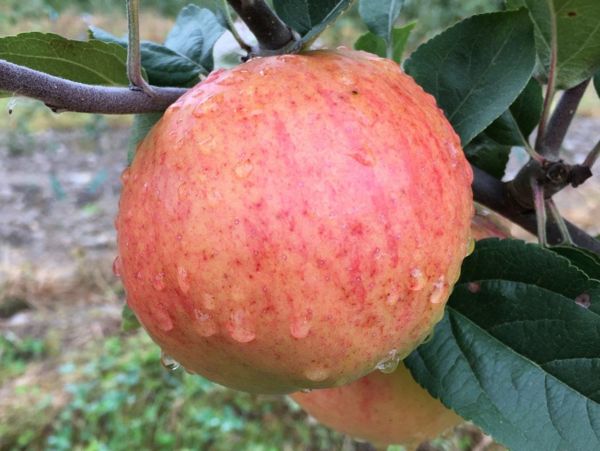An attractive, highly disease-resistant apple, ideal for organic growers.
Apple Scab
Fruits Affected
Also See
Fruit Tree Diseases and Pests: An IntroductionList of Common Fruit Tree Diseases and Pests
Apple scab is caused by the fungus Venturia inaequalis. This fungus overwinters on fallen diseased leaves, and in spring, the fungi shoot spores into the air.
Symptoms
Spots on leaves; brown-black spots on fruit.
Organic Treatments
The first and best defense against apple scab is to plant resistant varieties. Some varieties, such as McIntosh and Cortland are notoriously susceptible to scab, while others, especially modern cultivars bred especially for disease resistance, are less prone to infection, e.g. Winecrisp, Goldrush, Liberty, and Pixie Crunch. (It should be noted that "resistance" is not bullet proof, even for modern cultivars, as discussed in this Good Fruit Grower article: Scab Resistance Breakdown.) The majority of apples occupy a middle ground, and moderate levels of scab will be tolerable for most home orchardists but not for commercial growers. A few simple cultural practices can also significantly diminish scab levels. Dead leaves should be removed from the orchard floor in fall, and trees should be planted with sufficient spacing to ensure airflow. Likewise, annual pruning to keep the canopy open will help the tree dry quickly after rain. Remember: scab needs prolonged moisture to initiate infections. Spraying sulfur just before a rain from green tip through a few weeks after petal fall can keep scab under control.
Conventional Treatments
Spray urea in the fall after the leaves have fallen, then mow the leaves thoroughly. This will help break down the inoculum. There are many fungicides available to a grower. Most of them do not require a restricted license. Sulfur, Captan, Merivon, Inspire Super, and Sovran are some common chemicals. Be sure to rotate chemistry throughout the scab season.
Disease Cycle
Apple scab is caused by the fungus Venturia inaequalis. This fungus overwinters on fallen diseased leaves, and in spring, the fungi shoot spores into the air. The fresh spores are carried by water or wind to newly developing leaves, flowers, fruit or twigs. Spores need several hours of moisture on the plant surface in order to start new infections, and the new infections grow into spots that can produce more spores within a week or two. The infection cycle can repeat many times throughout the growing season whenever leaves remain wet for long enough. Warm, rainy weather in the spring and summer creates ideal conditions for apple scab, as the moisture both allows the disease to enter the tree and facilitates spreading of spores.
The symptoms of this disease appear on the leaves and fruit. Leaves develop round, velvety, olive-green spots with fringed borders. These spots can expand and merge. Infected leaves may turn yellow and drop by mid-summer, which weakens the tree. Several years of early leaf loss can result in decreased growth, reduced bloom, and increased susceptibility to winter injury. Infections on fruit are easiest to positively identify; these appear as olive-green spots that can become brown, black, corky, and cracked over time.
For further information, see the Cornell Guide to Growing Fruit at Home and the Cornell Cooperative Extension Factsheet on Apple Scab.
Featured Products
A few things we're loving right now...
A full-flavored, freestone white peach.
A traditional semisharp cider apple from Spain.
A widely-grown, large, yellow-fleshed nectarine.






























